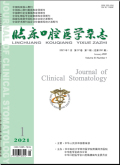临床口腔医学杂志2024,Vol.40Issue(4):195-199,5.DOI:10.3969/j.issn.1003-1634.2024.04.002
小鼠舌白斑的转录组学特征和信号通路改变及白介素17A单抗治疗的实验研究
Experimental study on the transcriptomic characteristics and signaling pathway alteration in mouse tongue leu-koplakia and effect of anti-mouse IL-17A monoclonal antibody on leukoplakia
摘要
Abstract
Objective:To explore the transcriptomic characteristics and signal pathway changes of mouse tongue leu-koplakia formation and malignant progression,as well as the therapeutic effect of interleukin-17A(IL-17A)monoclonal anti-body on mouse tongue leukoplakia.Methods:RNA-sequence was performed on human normal tongue mucosa tissues(NM),tongue leukoplakia(OL)tissues with epithelial dysplasia from the same patient,normal mucosa tissues,and leukoplakia tis-sues(mOL)from the tongue of 4NQO-induced mice.After 12 weeks of 4NQO induction,the mice were divided into two groups:experimental group(intraperitoneal injection of anti-mouse IL-17A monoclonal antibody)and control group(intraper-itoneal injection of IgG1 isotype control antibody),the dosage of monoclonal antibody was 10 mg/kg/w.Tissue samples were collected after four weeks'injection.And the histopathology of the mouse tongues were performed by hematoxylin-eosin stai-ning(HE staining)and immunohistochemistry staining(IHC)of Ki67.In vitro,the leukoplakia cell lines(DOK,Leuk1)were stimulated with recombinant human IL-17A respectively and cell cycle was analyzed by flow cytometry.Results:Comprehen-sive analysis of the transcriptomic sequencing results of humans and mice showed that the IL-17 signaling pathway was signif-icantly upregulated during leukoplakia formation.The histopathological evaluation results after four weeks of Anti-mouse IL-17A monoclonal antibody treatment showed that 80%of the mouse tongues in the experimental group had mild to moderate epithelial dysplasia,while 20%had severe epithelial dysplasia.In the control group,40%had mild to moderate epithelial dys-plasia,40%had severe epithelial dysplasia,but 20%had infiltrating cancer.The results of Ki67 showed that the proportion of cells in the proliferation stage in the control group was significantly higher than that in the control group(P<0.05).And flow cytometry showed that IL-17A stimulation led to more concentration of cells in the S-G2-M phase(P<0.05).Conclusion:The IL-17 signaling pathway is significantly upregulated during the formation and malignant progression of leukoplakia in hu-man and mice tongues.Anti-mouse IL-17A monoclonal antibody has potential therapeutic effect on 4NQO-induced mouse tongue leukoplakia.IL-17A promotes the proliferation of leukoplakia cells.关键词
转录组测序/IL-17信号通路/4NQO小鼠口腔白斑模型/IL-17A单抗Key words
RNA-seq(RNA sequencing)/IL-17A signaling pathway/4-NQO mouse oral leukoplakia model/Anti-mouse IL-17A monoclonal antibody分类
口腔医学引用本文复制引用
韩馨怡,张倩倩,王子瑞,周曾同,唐国瑶,施琳俊,沈雪敏..小鼠舌白斑的转录组学特征和信号通路改变及白介素17A单抗治疗的实验研究[J].临床口腔医学杂志,2024,40(4):195-199,5.基金项目
国家自然科学基金项目(82370954,82170952) (82370954,82170952)
上海市卫生健康委员会2020年度综合医院中西医结合专项立项一般项目(ZHYY-ZXYJHZX-202016) (ZHYY-ZXYJHZX-202016)
上海交通大学医学院附属第九人民医院医学研究培育基金(JYZZ182) (JYZZ182)
上海交通大学医学院附属第九人民医院研究型学科(KQYJXK2021) (KQYJXK2021)
上海市教委口腔高峰学科——临床医学"研究型医师"(双百人)(2022sbr-slj) (双百人)
科技部国家重点研发计划(SQ2022YFC2400066) (SQ2022YFC2400066)

